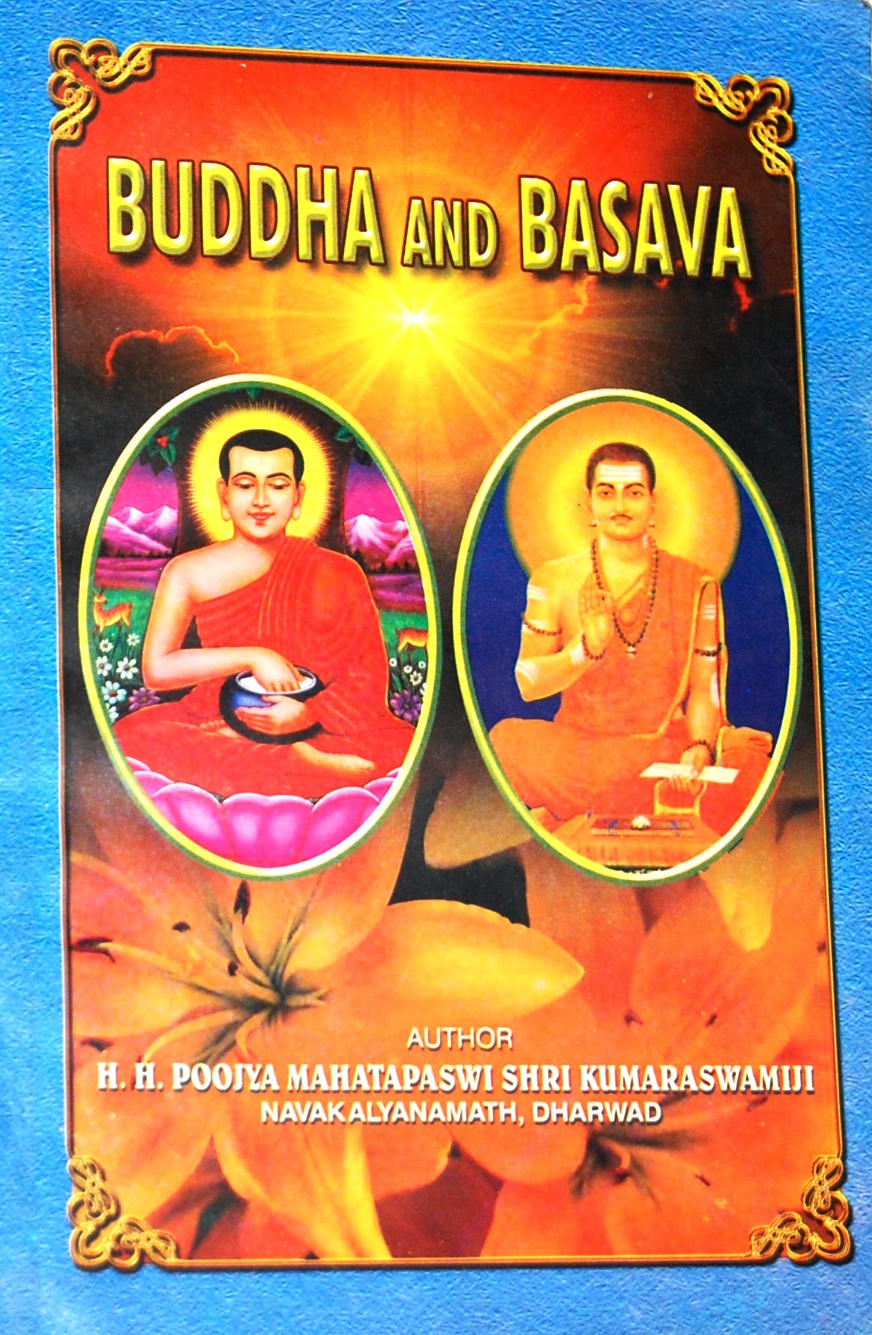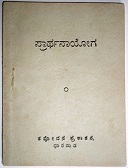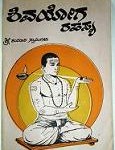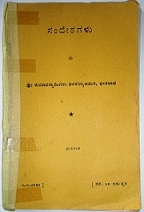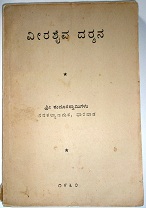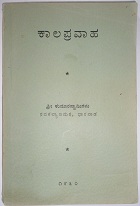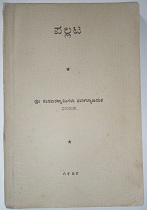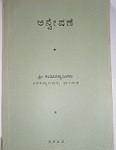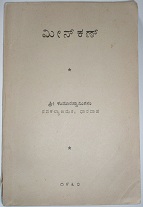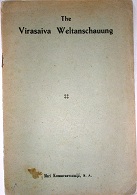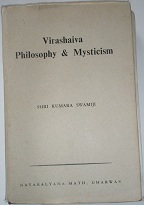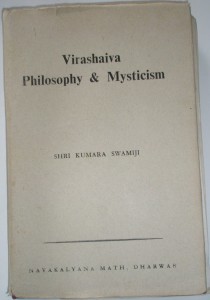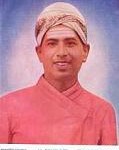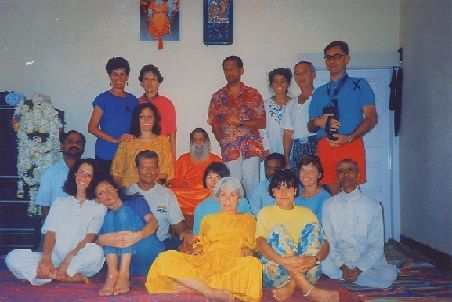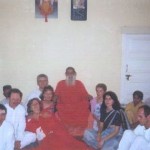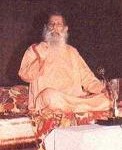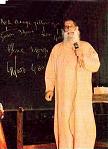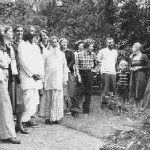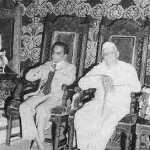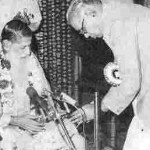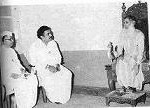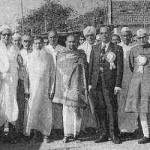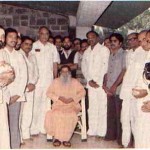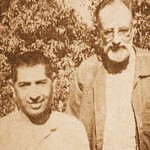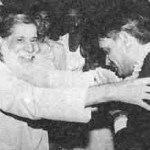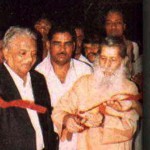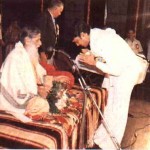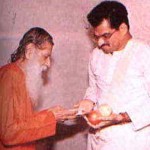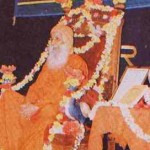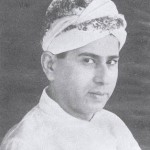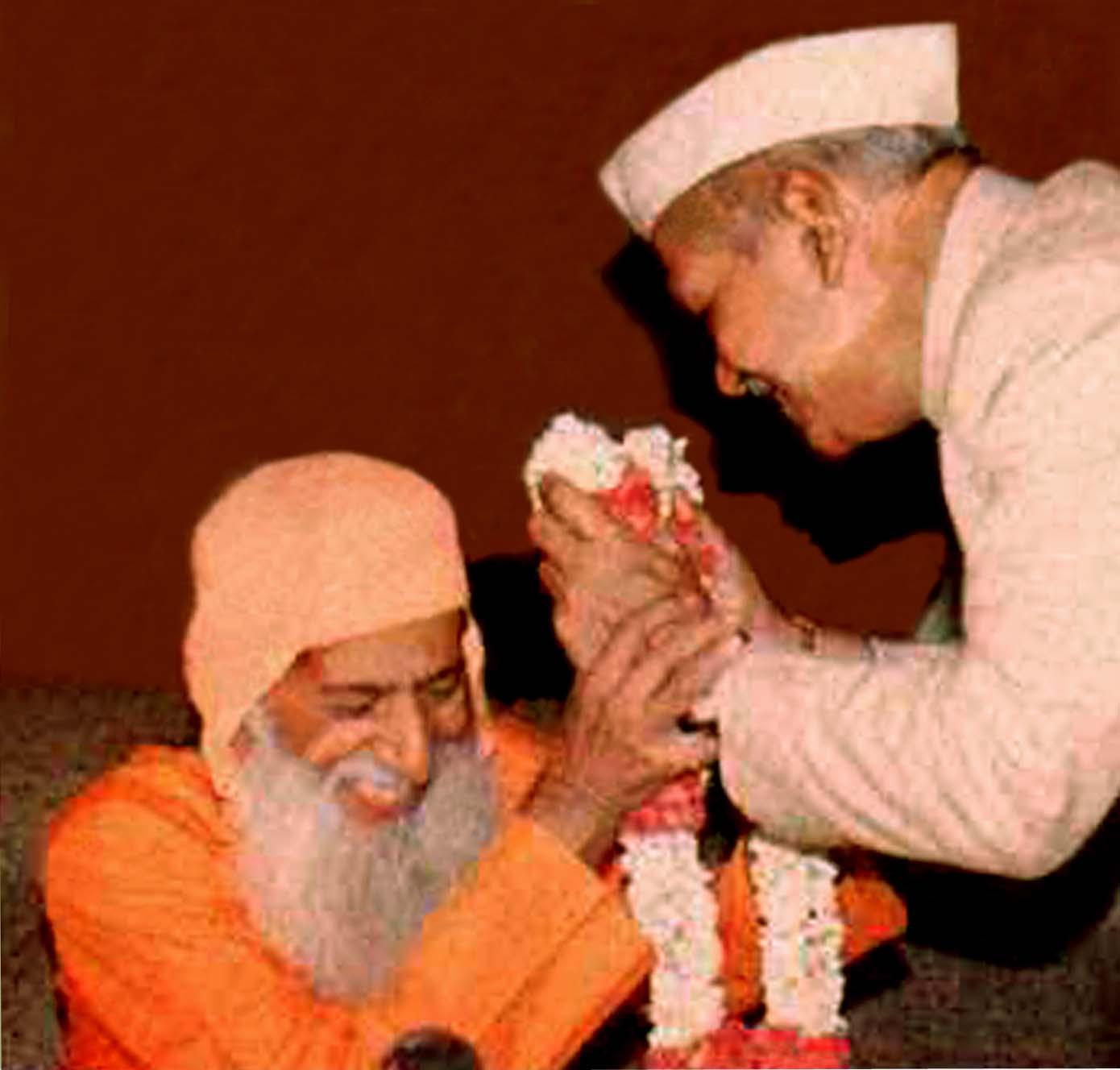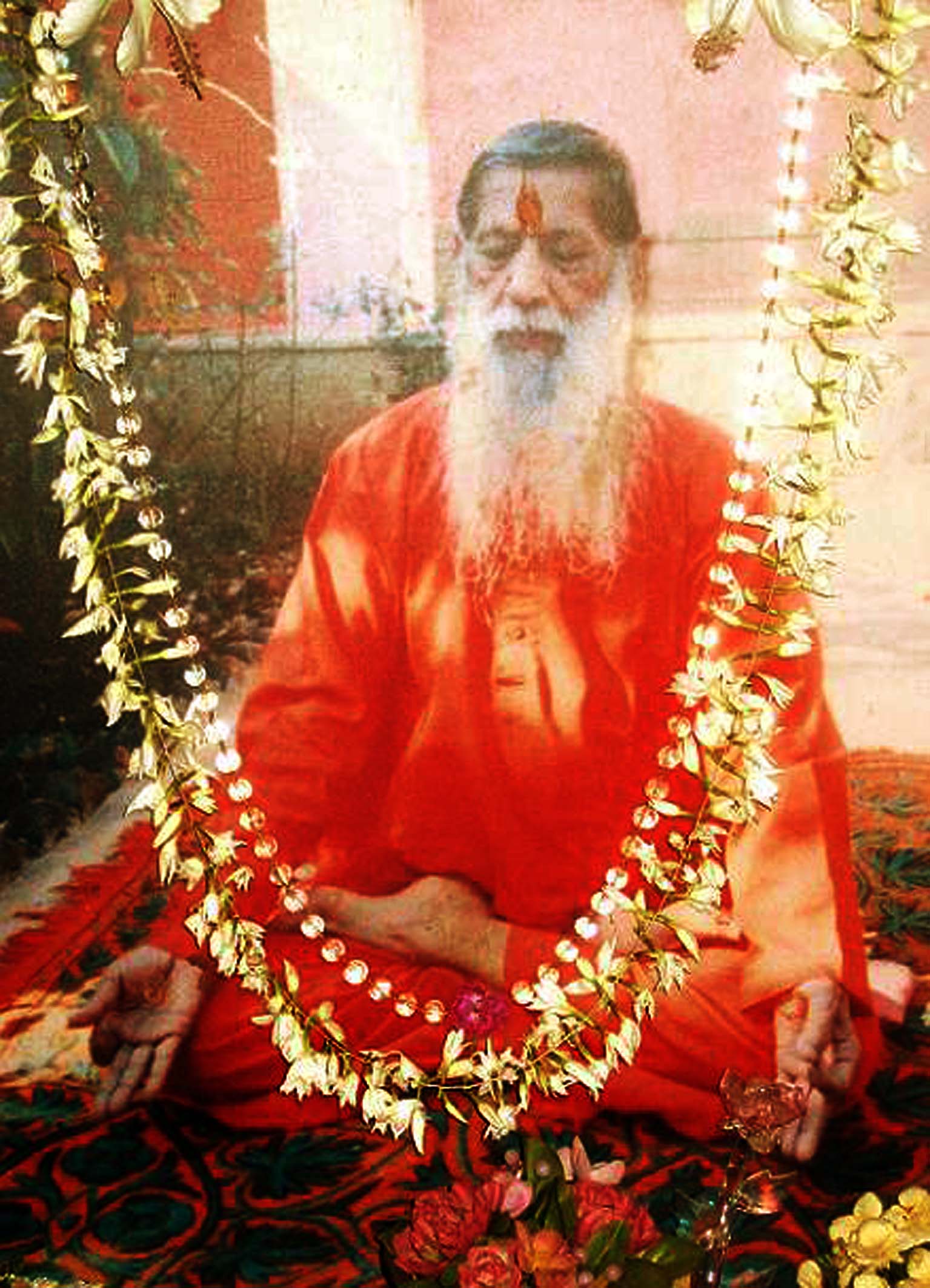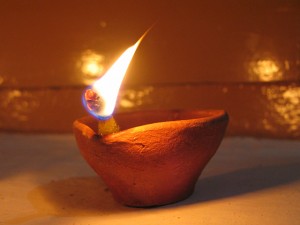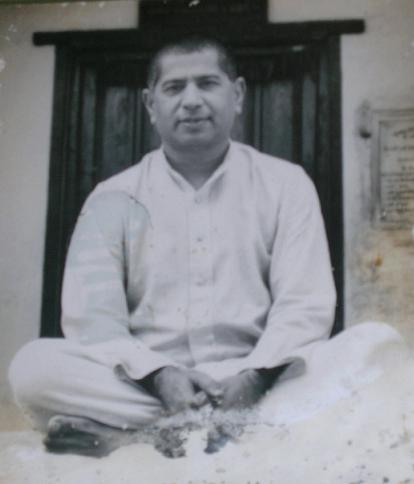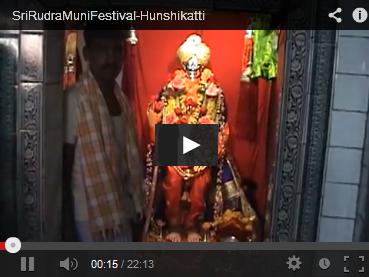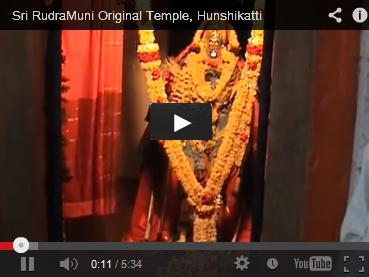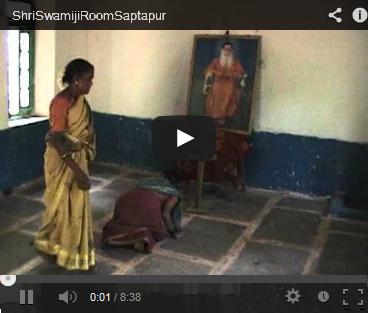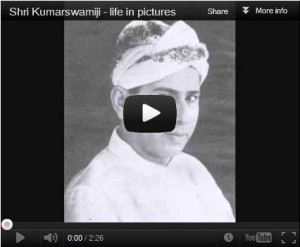Shiva-Shakti-Sharana is the holy Trinity which is the refrain of Veerashaiva mysticism. In theology, it assumes the form of Linganga Samarasya. Shiva is Linga, Sharana is Anga and Samarasya or identity is achieved by the ingress or infusion of the Divine power Shakti. But this identity is not accomplished all at once; it needs a gradual process which is attended with six stages or steps in psychic opening. Hence the theological aspect of Shatsthala is characterized by an ascent and a descent, ascent of Anga or soul from the sense of self-division and the limiting influence of matter, and descent of Linga or God in love, light and bliss to reveal the treasures of spiritual life.Linga is upasya, the worshipped; Anga is Upasaka, the worshipper; and Bhakti is Upasana, the worship. Shat-sthala is a hierarchy where Upasana grows step by step, gaining in content till the apparent duality between Anga and Linga vanishes and Samarasya or at-oneness is achieved.
The individual becomes,
Bhakta by virtue of his belief in God,
Maheshvara when the belief matures into an unflinching faith,
Prasadi if he remains vigilant therein,
Pranalingi when he gains enlightened self-experience,
Sharana on the strength of sustained awareness thereof and
Aikya when he attains the final beatitude
Arising out of the union
Of awarness with the Absolute
– Shunyasampadane.
In Veerashaivism, Sthala has a metaphysical as well as a psychological connotation. Metaphysically it means God who is the source and support of all existence, the ground and goal of all evolution. Psychologically it means a stage, a step or a halting place in consciousness for the soul on its journey towards spiritual life. Spiritual life has a law of inversion which exhibits a constant tendency in man to become God, and a contrary tendency in God to become man; without these tendencies there can be no concrete spiritual life. Indeed, the mystery of concrete spiritual life lies in this law of contradiction which displays the humanity of God and the divinity of man. In the absence of this contradictory life, either in the divine or in the human, cannot become rich and exquisite in beauty. Spiritual life has its charm because there is a constant seeding of the Divine by the human and a constant yearning for the human in the Divine. This yearning and the seeking make spiritual life a mystery, which cannot be understood completely.
Spiritual life has no meaning, unless there is identity or akinness with God. But Vaishnavism with all its akinness of spirit emphasizes the categorical distinction between the human and the Divine. Its philosophy does not allow a complete merging or dynamic identification. Its approach is theistic, but its realization is a spiritual fellowship with the Divine in love. The initial approach of Veerashaivism is also theistic, but in its realization it insists more upon identity than upon difference. The devotee is anxious to be more and more God like. God is anxious to enjoy the blessedness of devotional consciousness. To exhibit the finest beatitude of God at times assumes the attitude of the seeker and reveals to humanity the dynamic identification of the lover and beloved. Veerashaivism exhibits this contradiction. The son becomes God or Shiva. The Divine Mother reveals the Shiva-hood where the son-ship is sincere and complete. The son (Sharana) becomes the Father (Shiva) as the Father becomes the son through the intervention of the Divine Mother (Shakti). Whatever be the form, spiritual life in essence implies a fulfillment through contradictions. This law of contradiction or spiritual inversion attains fruition in Shatsthala.
Shiva-Shakti-Sharana is the holy Trinity which is the refrain of Veerashaiva mysticism. In theology, it assumes the form of Linganga Samarasya. Shiva is Linga, Sharana is Anga and Samarasya or identity is achieved by the ingress or infusion of the Divine power Shakti. But this identity is not accomplished all at once; it needs a gradual process which is attended with six stages or steps in psychic opening. Hence the theological aspect of Shatsthala is characterized by an ascent and a descent, ascent of Anga or soul from the sense of self-division and the limiting influence of matter, and descent of Linga or God in love, light and bliss to reveal the treasures of spiritual life. The Divine is addressed as Sthala. The Divine is really unlimited, but the inherent, inalienable power in the Divine in its sheer plenitude brings about limitation in the unlimited. Thus the Supreme or Shiva bifurcates Himself into Linga and Anga; and the divine power into Shakti and Bhakti. Here we must mark the meaning of Bhakti. Bhakti generally means the feeling of devotion or attachment to the Godhead. But here Bhakti means upasana or worship, which represents a spirit of self-surrender. This is not to say that worship can be performed without devotional feelings, for these are at the root of all worship. Linga is upasya, the worshipped; Anga is Upasaka, the worshipper; and Bhakti is Upasana, the worship. Shatsthala is a hierarchy where Upasana grows step by step, gaining in content till the apparent duality between Anga and Linga vanishes and Samarasya or at-oneness is achieved.
Shata-sthala – Six Stages of Evolutionary Consciousness
The one Sthala becomes divided into Anga and Linga, each of which again undergoes a threefold modification. Thus we have three forms of Anga, namely, Tyaganga, Bhoganga, and Yoganga correspondingly the three forms of Linga, termed Ishta, Prana, and Bhava. The soul in the waking condition is known as Vishva-jiva, that in the dreaming condition as Taijas-jiva, and that in the condition of deep sleep as Prajna-jiva. Tyaganga means the transformed Vishva-jiva. He gives up attachment to worldly objects and so is called Tyaganga, because tyaga or detachment becomes the means through which he realizes his divine nature. Ishtalinga becomes the object of worship to a tayag-angin. Bhoganga means the transformed Taijas-jiva. The subtle body is the means through which the Taijas-jiva experiences pleasure and pain by means of sensuous objects. The devotee, having given up carnal objects and taken to the realization of the Self, takes delight only in what is conducive to spiritual growth. Hence he is called Bhoga-angin to whom pranalinga becomes the object of worship. Yoga-anga means the transformed prajna-jiva. He, being entangled in the causal body, the matrix of ignorance and vasanas (desires), remains separate from Shiva. But the mind and the sense having changed their natural course, the devotee realizes in everything the divine peace and presence. So the old causal body is destroyed, and a new state of consciousness is formed. Hence it is called Yoga-anga, as it leads to union of Anga and Linga. Bhava-linga becomes the object of worship to a yoga-angin. Ishtalinga, Pranalinga and Bhavalinga are therefore the three aspects of the Divine. Ishtalinga is the individual Divine extending itself in the realm of events or actualities. “It fulfills what is contained in the truth, what works out the possibilities reflected by the mind, and what appears to us as the fact objectively realized.” Pranalinga is the universal Divine which takes its stand on the possibilities. It has behind it the freedom of the finite. Therefore every action in the world seems to emerge from a balancing and clashing of various possibilities. Bhavalinga is the infinite divine which sees the truth in itself, as the truth in its becoming as well as in its essence. It contains comprehensively and not separately all that emerges as ideas.
Then the three modifications further become twofold each. Thus Ishtalinga becomes Acharalinga, the practical, and the auspicious and Charalinga, the dynamic; and Bhavalinga becomes Prasad-linga, the gracious and Mahalinga, the great. Likewise, when tyaga-anga becomes Bhakta, who is characterized by a state of faith (Shraddha-bhakti) in acharalinga, it is bhakta-sthala; and when it becomes Mahesh characterized by firm faith (Nishta-bhakti) in Gurulinga, it is Mahesh-sthala. Bhoganga becomes prasadin, who is characterized by a state of undivided attention (Avadhan-bhakti) to Shivalinga, and this is prasadi-sthala; and when it becomes pranalinga characterized by a state of experience (Anubhava-bhakti) or Charalinga, it is pranalingi-sthala. Yoganga becomes Sharana, who is characterized by a mode of pure delight (Ananda-bhakti) derived from the contemplation of prasadlinga, and this is Sharana-sthala; and it becomes Aikya characterized by a state of identity (Samarasya bhakti) with Mahalinga, the great and this is Aikya-sthala.
The sthala of Veerashaivism can be compared with the tattva of the Shaiva Siddhanta. Tattva literally means “thatness” hence it denotes Reality, a real ultimate factor of the cosmos. The tattvatraya of the Shaiva and Veerashaiva schools are three real and ultimate factors of the cosmos. But tattva also means a definite stage of evolution, a stage having individual characteristics of its own. In the Sankhya, evolution stops at Prakriti, whereas in the Shaiva systems it extends to the realm of Maya and Shakti. This Shakti, which is otherwise known as bindu, is inherent in Shiva, the Nada. The perfect equilibrium between Nada and Bindu or Shiva and Shakti is designated Parashiva. It is due to the limitation of language that we have to use phrases like between Shiva and Shakti and Shiva is the Supreme Lord of Shakti. It must be borne in mind that the Lord and his lordliness are one and the same. Shakti is described as the hrdaya, heart and the sara, essence of Shiva.
Reality is ineffable and beyond any description; yet an attempt has been made in every religious system to formulate a philosophy about its nature. But this formulation is regarding reality as the creator of the universe and not as it is in itself. Reality as it is in itself transcends word, speech and thought. Yet for the purpose of understanding, it is styled Parashiva. As transcendent, it is described as Shiva, as immanent Shakti. Shiva and Shakti are not two separate realities but two phases or aspects of the same Reality. From Shakti onwards, differentiation becomes evident in the process of creation or manifestations. Shadakhya or Sadashiva, Ishvara, Sadvidya or Shuddavidya represents the different evolutionary stages in the cosmic consciousness. If Sthala and Tattva are identical and if Sthala is God or Linga in Veerashaivism, then the six Lingas of Veerashaivism namely Acharalinga, Gurulinga, Shivalinga, Jangamlinga, Prasadlinga and Mahalinga, closely correspond with the six Tattavas of Shaivism which go by the name of Sadvidya, Ishvara, Sadashiva, Shakti, Shiva and Parashiva.
Mahalinga, the supreme Parashiva, is of the nature of pure bliss and all complete in itself. The unmanifest universe is latent in Mahalinga as an idea. The ideal universe lies hidden in Mahalinga as the foam, waves and bubbles are hidden in the sea. The Shakti of Mahalinga is Chit-Shakti which is defined Chamatkrti � wonderment of integral I. The Kala of Mahalinga santyati-tottara, super-peace. Prasadlinga, the Shiva-tattva, is the first manifestation, and the power of being predominates in it. It is purely subjective and has no objective reference. It is entirely free from Mala-traya. This is why it is described as Prasanna, pure and clear. The Shakti of Prasadlinga is Para-shakti, the power of self-consciousness. The Kala of Prasadalinga is Santyatita, peace without vibration. Jangamalinga, the Shakti-tattva, represents the simultaneous manifestation, the manifestation of Shakti with Shiva, of consciousness with being, for consciousness pre-supposes being as the rays do the flame. The Shakti of Jangamlinga is Adhishakti, the primal power which gives rise to the first concept of the universe. It is here that Spanda takes place; hence the Kala of Jangamlinga is described as Shanti-kala or peace with vibration. Shivalinga, the Sadashiva-tattva, represents the idea of good, it is for the first time that the will to produce the universe for the good of selves arises. This is why the Shakti of Shivalinga is Iccha-shakti, desire to create, and the kala is vidya or conception. Gurulinga, the Ishvar-tattva, represents the formative stage of the universe. It is here that concrete planning of the universe takes place. Jnana, the power of formulation is the Shakti of this tattva and the Kala of Gurulinga is Pratishta, the perception or formulation. Achara-linga, the Sadvidya-tattva represents the full effectuation. Here the universe appears in the full-fledged form. The form, name and function of things become clear and definite. The Shakti of Acharalinga is Kriya or activity which brings the universe into form and name. The Kala of Acharalinga is Nivrti, the phase of explication or effectuation.
Closely connected with the classification of six Lingas is the division of six Angas which are known as the Bhakta, Mahesha, Prasadi, Pranalingi, Sharana and Aikya. Bhakta is the devotee of Acharalinga with Shraddha-bhakti or love and faith. Mahesha is the devotee of Gurulinga with Nishta-bhakti or firm faith. Prasadi is the devotee of Shivalinga with Avadhana-bhakti or undivided attention. Pranalingi is the devotee of Jangamalinga with Anubhava-bhakti or intuitive experience. Sharana is the devotee of Prasadlinga with Ananda-bhakta or a mode of pure delight. Aikya is the devotee of Mahalinga with Samarasya-bhakti or unitary consciousness. This is the theological aspect of Shatsthala, the secret of which is based upon the feeling of the worshipped and the worshipper or upasya-upasaka-bhava.
Shata-sthala – Six Stages of Evolutionary Consciousness
As individual has to pass through the stages of Pinda, pinda-jnana, samsarheya, Gurukaruna and linga-dharana before he can claim himself a Bhakta. Pinda is a technical term which means a purified individual. An embodied soul or jiva, after exhausting the accumulated impurities becomes pure and turns his devotion to God. All souls cannot cherish a God-ward tendency; it is only a soul in whom an aspiration for spiritual life has been kindled that can hunger and thirst for God. Such a hungering and thirsting soul is known as Pinda in Veerashaivism. This hunger for God awakens in him a sense of discrimination or the viveka which distinguishes between the self and not-self, between the real and the apparent. This is embodied in Pinda � jnanasthala. In this stage the individual instinctively feels that he is the self or Atman and not the body, and comes to the conclusion that he is different from body but related to God who is its master. This viveka is immediately followed by Vairagya or dispassion. True vairagya is born of discrimination and not of mere failure in life. Real dispassion results from the perception of the impermanence of things, the evasive happiness of sense-objects and the knowledge of the distinction between reality and appearance. Be it noted that this Vairagya or distaste is only initial and not final, and it is essential for generating dissatisfaction with the present state of things. This is the Samsarahaya-sthala. Next the individual desires to be relieved of worldly entanglements and hence he is in search of a Guru, who accepts him by initiation. This is the Guru-karuna-sthala. Books will be of little avail to reveal the difficulties of the path of self-realization, while the master or Guru, who has realized the truth, is likely to take the disciple from step to step on the ladder of spiritual perfection hence the need of a Guru. Then the Guru performs Diksha or initiation to the disciple and invests him with Linga. This is known as Linga-dharana-sthala. The wearing of Linga in Veerashaivism follows as a necessity, for a Veerashaiva is also called a Lingayata, since the Linga he wears come from Guru. A disciple who always wears Ishtalinga upon his body is called Anga in Veerashaivism. The wearing of the Linga is followed by the application of vibhuti, sacred ashes to the body, by putting on the Rudraksha and by the repetition of the sacred mantra � Panchakashri or Shadakshari.
The first duty of a Bhakta is to worship Linga in the early morning. Basava says: “If one worships Linga with ungrudging love in the dawn, one will be freed from the fetters of Karma.” The second duty which is equally important is to offer obeisance to the devotees. Prabhu’s saying is relevant to this discussion:
“To get up at the first faint streaks of dawn
and worship Linga,
And to greet the saints of Shiva,
at the earliest sunrise,
It is a practice worthy of life.
It is a truth indeed.
I discard those, Oh! Guheshvara!
Who observe it not.”
The third duty is to observe humility, which is denoted by the word Dasoham. True humility is not self despising spirit, but it is a true estimate of ourselves as God sees us. Learning or character shine with a double luster when accompanied by humility. In the Bhakta-sthala this humility is directed towards Guru and Jangama. Guru is the preceptor and Jangam is the person. Guru initiates the disciple into the secrets of Linga or the principle, and Jangam is he who has embodied the principles of truth. Usually Jangama is much helpful to the devotee and for this reason the latter cherishes a deep devotion to Jangama. Bhakta is requisitioned to have simple, sincere and disciplined devotion to Jangama instead of undisciplined, blind and superstitious faith. Jangama is described as the mouth of Linga, meaning thereby feeding Jangama is like feeding Linga. When a tree is watered at the bottom it goes direct to the branches and foliage, when a man has taken a bath in the sea he may be said to have bathed in the holy waters of the land. When nectar has been once enjoyed all the flavors are forthwith experienced. Similarly when Jangama has been worshipped all the desires become fulfilled. When Jangam approaches the door of Bhakta, it is his duty to offer him obeisance.
In Veerashaiva theology there is a Trinity of Guru, Linga and Jangama, upon which the Bhakta is required to look with an eye of equanimity. The sincere devotion to God or Linga has a magical charm. The most illiterate man who is touched with devotion, cultivates a certain greatness of mind mingled with a noble simplicity, that raises him above others of the same condition. Bhakta is enjoined to make offerings to Guru, linga and Jangama. Things obtained either through the labor of man or through the love of God should be offered to the Jangama as he is the mouth of Linga. The Jangama, who has renounced all earthly attachments and who roams from village to village to impart spiritual knowledge to the people at large, never craves for the things which the devotee places at his feet. He touches and returns them with a blessing. Of all the things man’s daily food or diet forms an important part and it is offered to the Jangama for consecration. Jangama touches the food and his magnetic touch transforms it into Prasada. In the Bhakta-sthala this procedure is essential.
Strict observance of moral codes, such as adhering to truth, looking on all as equals, honoring those that deserve honor, leading a calm and contented life and service to fellow creatures, is another feature of Bhakta-sthala. This is compressed in the Sanskrit word Achara, and it is for this reason that Acharalinga is connected with Bhakta-sthala. Purity of food, purity of body and purity of work are looked upon as essential observances in the Bhaktasthala. Food is better than physique; everyone should be his own physician. Nothing is good for the body but what we can digest. What can procure good digestion? Exercise. What can recruit strength? Sleep. What will alleviate incurable evils? Patience. Veerashaivism gives a lot of importance to manual labour, as it is necessary to provide exercise to the body and limbs. When a man works hard in the open air within the limits of his own strength, he gets sound sleep; and faith in God teaches man to bear patiently the ills and adversities of life.
Psychologically Bhakta-sthala is characterized by the tender emotions which cluster round God crystallizing into devotion, the religious emotion par excellence. Devotion is a highly compound emotion consisting of wonder, fear, gratitude and negative self feeling. Belief in the distinctness of God from soul is ever alert in this stage. Because of this belief, negative self feeling becomes a necessity, but it must not transcend its bounds. All tender emotions tend to shoot-upward in the atmosphere of life. Sometimes the taste for emotion for emotion’s sake may prove dangerous; mere emotion has no value in the Veerashaiva system, save as it is connected with right conduct. Hence Bhakti or devotion and Sadachara or right conduct always go together in Bhaktasthala. Emotion is the bud, not the flower, and is of no value until it expands into the flower. Every religious sentiment, every act of devotion which does not produce a corresponding elevation of life is pernicious because it ministers to self-deception and tends to lower the tone of personal morals.
In the second stage known as Mahesh-sthala faith in God, or Linga grows in intensity till it ripens into patience. The Mahesha is required to worship one and only God in the form of Ishtalinga which is bestowed upon him, at the time of birth by the preceptor. He, therefore, looks upon Ishtalinga as the emblem of the Supreme, and becomes so much convinced of the purifying nature of the Linga that he never parts with it, even at the risk of his life. In Shrutis, there are some Mantras called Avahana and Visarjana � the mantra for inviting Gods to accept worship, and the mantra allowing Gods to leave after the completion of puja. Veerashaivism refuses to observe these mantras, because it believes in the presence of God always in the individual in the form of Ishtalinga. In this stage, this is emphasized. The upshot all of this monotheism, pure and simple. Monotheism or the belief in one God is comparatively a later development in the history of religious thought. It seems more probable that the religious beliefs of mankind are in the first instance, a vague concept of nature as animated by spirits which is known as animism. And the passage from animism to polytheism or belief in many Gods may be traced by with a high degree of probability. But the polytheistic concept of the world outrages the demand for coherence which is motive of intellect, and the demand for supremacy of the law of righteousness which is the inspiration of moral consciousness. Hence monotheism came to be the creed of Veerashaivism. Prabhu’s saying reflect this effect:
“They are neither brave nor resolute
Who, not knowing to ride upon a ready horse
Ask for a different one.
That is why, the three worlds
Are foolishly toiling
Carrying the heavy saddle on their back
Oh! Guheshvara!”
In this saying ready horse, symbolizes Ishtalinga. He who fails to worship Ishtalinga with faith and patience and who seeks the favor of other gods which is symbolized here by asking for a different one, is not Mahesha.
Monotheism is theism with the belief in one God. Theism holds that there is one God who is the ground of all finite existence, himself, in some sense distinct from the world. Theism has usually maintained that God is personal and that he must be thought of as morally good and holy. The mystic subscribes himself to this view, and he thereby preserves the freedom as well as the responsibility of finite souls in the bosom of the Absolute. In the Mahesh-sthala this theism has been maintained and a spirit of monotheism inculcated.
There is an element in Mahesh-sthala which goes by the name of Ashtamurti nirasana � the discarding of eight forms. The earth, water, fire, air, ether, the moon, the sun and the self, these eight are considered to be the eight-fold body of Shiva in Shaivism. It is for this reason that Shiva is known as Asta-tan-murti or Enmai. This is a rather cosmological explanation of Shiva. Veerashaivism leans more towards the theological explanation. Eight forms are the outcome of lower nature or Apara-prakriti. In Veerashaivism lower nature is considered to be impure and its evolutes are bound to be impure. But they have to be purged of their impurity which is known as Purvasraya by the touch of Para-prakriti or spiritual nature. The eight fold evolutes of lower nature should be turned into eligible moulds for the soul by the eight-fold aids or Ashtavarna. Which are the outcome of higher nature. They are Guru, Linga, Jangama, Padodaka, Prasada, Mantra, Vibhuti and Rudraksh. In the Mahesh-sthala the process of transformation is indicated, and he is a Mahesha who has achieved this transformation of the lower nature into the higher one through the instrumentality of Ashtavarna. Now Mahesha is in a position to guide those that are in the lower stage hence the Linga connected with this stage is named Gurulinga.
The individual at times grows impatient and tries to seize over the divine by force, but impatience only mars the progress. Spiritual progress requires patience and patience is a necessary lesson for Mahesha. Mahesha is one who has an unflinching faith in God without being impatient, he will hold on to Linga, hold it fast and hold it out. Life is best with hard conditions that every dear and precious gift, very rare virtue, every genial endowment must sometimes be put into the crucible to distill the patience. The two traits which constitute the Mahesha-sthala are bearing and forbearing. Mahesh is therefore he who bears and forebears.
Psychologically the object of Mahesha-sthala is purgation. Purgation is freedom, freedom from the fetters of the sense, the remora of desire from pride and prejudice, from self-hood in every form. The self, in this stage is to be purged of all that stands between it and goodness. Purification is a perpetual process which involves the drastic turning of the self from the unreal to the real life, from the even tenor of easy-going life to the uneven stress of hard and ascetic life. Here asceticism finds its justification, for the Mahesha has to observe certain vows and moral precepts. By asceticism is to be understood the positive aspect of purification, the remaking in relation to reality of the permanent elements of character. In psycho-analytical language, �the process of asceticism is the process of setting up new paths of neural discharge’. It means that the spiritual life has had to express itself in action and for this; new paths must be cut and new habits formed resulting in a complete sublimation of personality. If the psychological basis of Bhakta-sthala is affective, that of Mahesha-sthala is cognitive. The cognitive drive of the psyche is here concentrated on the death of self-hood in its narrow individualistic sense. �All the twisted elements of character which foster the existence of this unreal yet complex ego are to be pruned away. Then, as with tree of the forest so with the self of man, new branches will spring up and grow towards air and light.’ This change of character is an index of Mahesh-sthala.
Faith in God and patience of the worldly trails foster in the individual a sense of obligation to surrender himself and all his belongings to God. This surrender forms the key-note of the third Prasadi-sthala. The surrender of Prasadi implies “The obedience of the illumined disciple of Truth, of the inner warrior who fights against obscurity and falsehood of the faithful servant of the Divine.” He is a Prasadi who receives the three-fold Prasada namely, Shuddha, Siddha and Para-siddha by surrendering body, mind and spirit to Guru, Linga and Jangama. The individual dedicates his body to Guru, his mind to Linga and spirit to Jangama. By this process of dedication the purity of body, mind and spirit is achieved and the purity of body is termed Shuddha Prasada, the purity of mind, Siddha Prasada and the purity of spirit, Para-siddha Prasada. Then he is rightly styled the vanquisher of Malatraya, namely, anava, maya and karmika, which cling to the body, mind and spirit.
Prabhu’s saying corroborates this statement;
“Who can apprehend the perpetuity or
Otherwise of the Trinity?
If one can gain the three-fold grace
By offering three-fold service to the Trinity
I call him the Lord of Trinity
I call him the brave
I call him a Prasadi
Oh! Guheshvaralinga!”
That the Prasadi should offer three-fold service i.e. his body to Guru, his mind to Linga and his spirit to Jangama is special feature of the Prasadi-sthala. If he offers these without being conscious thereof, it is a genuine offer or dedication. If the sense of ego is alive in the offer it is looked upon as anarpita or unoffered. The return of the former is said to be a divine grace or Prasada, while that of the latter shall be wages. One who is blessed with Prasada or grace is known as Prasadi. Hence Shivalinga is connected with Prasadi-sthala.
“The bundle of hay in the right hand
Has caught fire by a spark
in the left hand of thy Prasadi
Oh! Guheshvara!.”
This saying of Prabhu is highly significant. A spark in the left hand means a spark of knowledge; a bundle of hay in the right hand means a web of desires. Fire of knowledge burns the illusion of desires into the illumination of joy. What is desire? Desire is only a mode of the emotional mind which by ignorance seeks its delight in the object of desire and not in God who expresses himself in the object. By destroying that ignorance by self-knowledge one can perform an action without being enslaved by desire. Action is avoided because it is considered to be necessarily entangled in desire behind the achiness. But the Prasadi, whose actions are performed with a pure intention without the desire for rewards, acts with freedom. As joy expresses in law, so the soul finds its freedom in action. The Prasadi therefore does not preach its freedom in action, on the other hand he teaches the gospel that work is worship. Work becomes worship only when it is done in a spirit of gratefulness is so deep and powerful that it exalts the work that is rough and breathes a new life into the work that is dull.
Psychologically Prasadi-sthala represents the sharpening and purifying of the cognitive faculties consequently the purity of perception and clarity of thought are gained. The doors of perception are so cleansed that everything appears to the Prasadi as it is. In this stage, the actual physical perception seems to be strangely heightened so that the self perceives an added significance of reality in all natural things. In Prasadi-sthala, “human industry is joined together.” If the inner eye is to be opened, definite work must be done. So long as the eye which looks on time fills itself with things and usurps the conscious field, that spiritual or inner eye which looks upon eternity can hardly act all. This eye must be opened, it must be trained so that it may endure to gaze steadfastly at the Linga. This training and gaining of the inner sight is the goal of Prasadi-sthala.
Adepts in yoga call that Linga produced by the collision of Prana and Apana, the Pranalinga. The light, seen in the eyebrows, which otherwise is termed Jyotir-linga. The stage in which there is realization of the internal illuminating light through the process of yoga is known as Pranalingi-sthala. He is truly a Pranalingi whose Prana begins to course through the central nerve, the sense-organs of the individual are withdrawn, his vital breaths get pacified or steadied, his mind becomes calm and fixed on the internal vision of Shiva. The unstruck sound or anahat-nada also begins to be heard. During the peal of sound the pictorial representations of Pranava merge before the mind’s eye of the Pranalingi. As he hears the sound which diffuses itself into that of bell, violin, kettle, etc so that he sees different colors. If Prana becomes regulated and rhythmic all the sense organs which function at its bidding become sensitive to the play of visions and voices. When the movement of the breath begins to course through the central nerve, peace wells out in abundance. The Pranalingi, gets so much engrossed in that peace that somatic functions of Sushumna-nadi or the central nerve, the knowledge of his relation with the external world are held in abeyance and thereby he sees his self pervading the entire universe. Prabhu’s saying runs thus:
“Unimaginable is the gleam in the eye!
Indescribable is the ring in the ear!
Incomparable is the flavor on the tongue!
Incomprehensible is the peace welling out of the central nerve
Omnipresent is Guheshvara,
The immutable, the subtle and deathless.”
The Veerashaiva saints have uttered many a saying about Pranalingi-sthala. These sayings betray the awakening of Kundalini, the consequent experience of the visions and voices and the psychic opening. The saying are often clothed in spiritual symbology.
“Water assuming a form
Manifested in the body
The prime seat is installed
In the temple of the body
The breath worshipping at the
Entrance and center
Of the nine doored temple
Offered a wreath of flowers
Guheshvara was seated there.”
In this saying the life-force is symbolically described as Udaka or water. In the science of yoga, the life-force is called Kundalini. The power known as Kundalini is described as the primal force. It lies dormant in the body of each person. Occultism gives a graphic account of Kundalini as a juvenile serpent bathed in saffron, luminous like a flash of lightening and blazing like the flames of fire. It occupies three centers in the body � the base, the middle and the summit, referred to in this saying as Mula, Madhya and Adhishtana. Adhisthana is termed Shivapura in this vachana where Guheshvara or God is seated, whom Vayu or breath worships with a plethora of fragrance. This imagery, when unraveled means that prana or breath emits fragrance if it is regulated by means of yoga. In other words the purpose of Pranalingi is to awaken the Kundalini or the life-force by anu-sandhana of Ishtalinga or the concentrated attention thereof. The concentrated gaze upon Ishtalinga disciplines the movement of breath and brings about a sort of rhythm in the movement, thereby producing a smoothing smell which provides a plethora of fragrance to Shiva seated in Brahmarandhra.
Psychologically, the psychic opening or the opening of the heart is a fundamental characteristic of the Pranalingi-sthala. Prabhu calls Animisha, his Guru, a true Pranalingi because Linga forms a part and parcel of his life. When Prabhu took away that Linga from the palm of Animisha the life-force left Animisha and lingered in Prabhu raising his energy to the highest level. Prabhu felt the blessed grace of his Guru and adored him in the lotus of his heart. What yoga psychology means by heart is not the physical heart, but psychic heart. The heart is known as Anahata-chakra and it is the seat of intuition. According to the techniques of the Shata-sthala, anubhava bhakti or intuitive apprehension is a feature of Pranalinga-sthala. Affection and cognition proceed from intuition, the psyche. That is, as it were, the fountain from which emanate all three phases of conscious activity. The psyche is really an inner and deeper mind, the mind whose highest element is not a receptor for a concept but an intuition. This is the mind in which sensation, simple consciousness and self-consciousness are crowned with cosmic consciousness. Kant, Fiche and Shelling speak of an intuition, the nature of which is more intellectual than spiritual. According to Veerashaivism, intuition is of spiritual nature and reveals the Reality in an immediate contact which is above knowledge. Anubhava is not knowledge of this or that thing, but it is the consciousness to know and see in oneself, the being of all beings, the Ground and Abyss. The status of Pranalingi may be summed up in these words: “There occurs a spiritual illumination which would place the individual on a new plane of existence. To this is added a sense of immortality, a consciousness of eternal life, not a conviction that he shall have this, but the consciousness that he has it already. This stage is presided over by Jangamalinga.
In the next stage known as the Sharana-sthala, there is absolute surrender to God or Shiva. The final consummation of Bhakti, for chaste and unswerving devotion to God removes darkness and represents the state of communion with God. If in the Bhakta-sthala devotion is initial, in the Sharana-sthala, it is final. Prapti or Sharanagatha denotes absolute surrender. In the Sharana-sthala, nothing is reserved. The heart is purified of all desires, the intellect of all self-will, every duality is renounced. The whole world, seen and the unseen is recognized as Lila, as the supreme expression of Sacchidananda. Ahankara or egoism is blotted out in order that the Sharana may enjoy the bliss in the phenomenal existence, behold the presence of God. Such a beholding, such a rising of a radiant consciousness of the Other in natural things, is the essence of Sharana-sthala. It is the saving madness of which Plato speaks in the Paedrus. It is the ecstasy of the God intoxicated man. It is the lover, the prophet, and the poet drunk with life.
The Sharana drinks the cup of love, of joy and delight to its dregs at the fountain of divine life, because of his absolute self surrender to God. Sri Aurobindo writes thus: “If this attitude of perfect self-surrender can be even perfectly established, all necessity of yogic kriya inevitable ceases. For, then God Himself in us becomes the Sadhaka and the Siddha and His divine power works in us, not by our artificial process, but by a working of Nature which is perfectly informed, all-searching and infallibly efficient. Even the most powerful Rajayogi Samyama, the most developed. Pranayama, the most strenuous meditation, the most ecstatic bhakti, the most self denying action mighty as they are and efficacious, are comparatively weak in their results when set beside this supreme working. For these are limited to certain extent by our capacity, but this is illimitable in potency because it is God’s capacity. It is only limited by His will which knows what is best for the world and for each of us in the world and apart from it.”
The idea of Antaryamin or the immanence of God in the soul forms the special feature of Sharana-sthala. In this stage of the intimate relationship of Shiva and Sharana, of the Divine and the devotee is brought into bold relief. “If the relation of the two be comprehended, may it please be explained,” says Prabhu. The mystic or Sharana is a mystic by virtue of his belief in God. If he is asked why he believes in God, he answers that it is because he believes in himself, he feels it impossible to believe in his own existence without the belief in the existence of Him who lives as a personal, all seeing, all judging Being in his consciousness. Hence God is spoken of as the indwelling spirit seated not only in the heart of the individual but spread through all the cosmic activities. The indwelling of God or Immanence is “an infinite sphere in a point, an immensity in a center, an eternity in a moment.”
In the words of Black, it is:
“To see a world in a grain of sand,
And a Heaven in a wild flower
Hold infinity in the palm of your hand
And Eternity in an hour.”
God who is everywhere and who penetrates all things gives to the soul the power to feel His presence with certain fullness. If the attitude of the soul tends forward and outward, it cannot feel the presence of God though He is hidden in the heart. That is why, Eckart, the German mystic ejaculates: “God is nigh unto us, but we are far from him; God is within, but we are without; God is at home, but we are strangers.” Fenelon, the French mystic, expresses thus: Thou art, Oh! Father, so really within ourselves where we seldom or never look that Thou art to us a hidden God.”
The integral association of God and soul is adumbrated by mysticism often takes the form of symbolic companionship of the human soul and the Divine soul. This symbolic companionship is expressed in the heaven-ward journey of Indra and Kutsa seated in one chariot in the Veda; secondly the image of two birds on a tree in Upanishad; thirdly in the twin figures of Nara and Narayana who together undergo penance for the sake of knowledge in the Mahabharata. In the vachana literature it is expressed by the intimate relationship of Shiva and Sharana.
Out of the conscious intimate relationship of God and soul, there wells out ecstasy which fills the life of mystic and which inevitable tends to monopolize the field of consciousness. The sphere of consciousness is surcharged with ecstasy, consequent upon the death of all memory, the burning of all illusions and the drying up of all awareness. This is why Prasadlinga is connected with Sharana-sthala. Listen to Prabhu’s words:
“All memory is dead,
All illusion is burnt,
All awareness is dried up,
The form is eliminated
Is there a room for emotion or commotion ?
Lost is the body consciousness
And in the Linga is absorbed mind
Divine ecstasy gushes forth
Oh! Guheshvara!”
Modern psychology has struggled in vain to discredit this divine ecstasy. This saving madness, sometimes attributing to the psyche-mechanism of projection; sometimes to the wish-fulfillment of a more unpleasant origin. It is true that modern psychology has discovered the key to the understanding of human behaviour which is built upon the basis of innate tendencies that are in all essentials, very similar to the instinctive tendencies of animals. But it has failed to discover the source which lies in the communion of soul with God. True theism has for the most part found its inspiration in the mystic desires of the human soul to commune with the Divine essence. The sport or Lila of God is with mystic souls and their communion with Him is in the state of nakedness and in the state of innocence. But these states are observable in a child; hence a Sharana is a divine child. Thus we may sing with Wordsworth:
“Gently did my soul Put off her veil and self-transmuted, stood
Naked, as in the presence of her God.”
Last comes Aikya-sthala, the sixth stage which is characterized by a rarified psychological state of unitary consciousness that implies the invariable sense of unity, which accompanies the mystic experience. This stage represents the final and successful establishment of that unitary consciousness which has been struggling for supremacy throughout the pilgrim’s progress. The deepest and the richest levels of human personality have now attained light and freedom. The soul has at last unified with the Supreme, and with the cessation of stress and stir, spiritual strength has been liberated for new purposes. This is the metaphysical side of the Aikya-sthala. It has also its mystic side:
“I am lost in a trance placid and profound
And in an egoless state I am seated.
Would I see? I see not,
Would I hear > I hear not.
The grandeur of the Supreme Light
Pervades my entire being
Oh! Guheshvara!”
This saying of Prabhu reveals the mystic side of Aikya-sthala which is rich in meaning and resonant with stillness. Ecstatic trance or the complete introversion is the characteristic of the Aikya-sthala. The whole vitality of the Aikya is so concentrated on the transcendental Truth that body and brain alike are depleted of their energy in the interest of the supreme act. In this act of union the mystic sometimes says that he is conscious nothing. But in fact this expression is figurative; otherwise he would not have known that there had been an act of union. If his individuality were abolished, it would not have been aware of the attainment of God. That is why mystics of the very high order, like Prabhu, often take recourse to the paradoxical language. “In a wondrous fashion, remembering that we do not remember, seeing we do not see, understanding we do not understand, penetrating we do not penetrate.”
In the mystic act of union there is no suppression of life, but an intensification, a change in its form. As the state of being changes, the will and the temperament must necessarily be modified. The will becomes more in tune with its source and eventually the personal will merges upward into the universe and obeys implicitly the transcendent. Nor does this change and Acension mean any annihilation of the will-power; rather it increases to an immense force-fullness while giving it infinite calm and eternal patience. The temperament also is delivered from all lash of training and desire, from all urge of patience and pain. The state of being by which the Aikya differs from the ordinary man, is that by which he rises from the foundation of a perfect quality to the consciousness of one existence in all and embracing all he lives in that existence. He sees the movement of the whole universe as happening within himself, not in his ego or mind, but within the vast and infinite self with which he is now constantly identified. All action in the universe he sees as rising in this being out of the divine existence and under the stress of the divine truth. He begins to participate consciously in its working and to see all things in the light of a divine governance. Even when his actions move on a certain lines rather than others, he is not bound by them. It is evident that such an increasing wideness of vision must mean an increasing knowledge and if it be true that increasing force for works.
Mahalinga is connected with Aikya-sthala and the will of Mahalinga is known as Chit-shakti. In Chit-shakti vision and execution, knowledge and action are one and they are no longer separated from each other as in the individual will. The Aikya is perfect because he has direct vision of the Truth and lives in truth consciousness and when he does so his will becomes spontaneous law of the truth in him. Psychologically complete introversion is the sine quo non of the Aikya-sthala. Introversion is not regression but it is retreat within oneself, with the depths of the functional consciousness of the self. “It is a rich and luminous simplicity which achieves the dispersion of analysis by surpassing and overcoming it. It is the fruit of interior action, the state of inner freedom, of a fusion of the pacified soul with the perfect Being.” The process of introversion is accompanied by the ascent of the vital breath which finds its culmination in the cavity of Brahmarandhra, wherein all organic functions and all psychic forces meet and there the Aikya enjoys not only unity but immortality.
This article – Shata-sthala – Veerashaiva Mysticism – is taken from H.H.Mahatapasvi Shri Kumarswamiji-s book, ‘Veerashaivism: History and Fundamental Concepts’.











